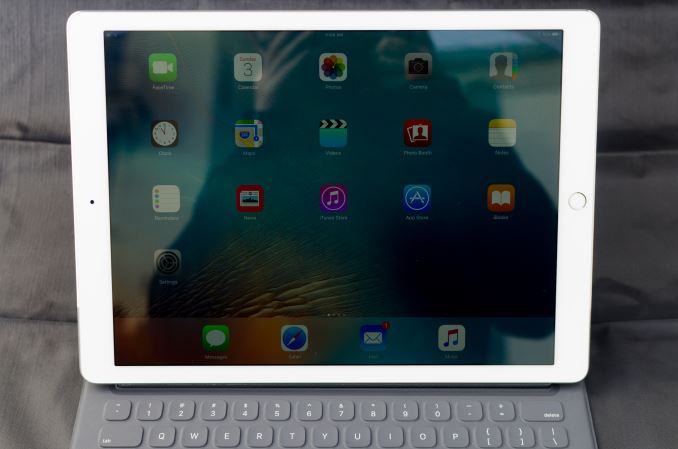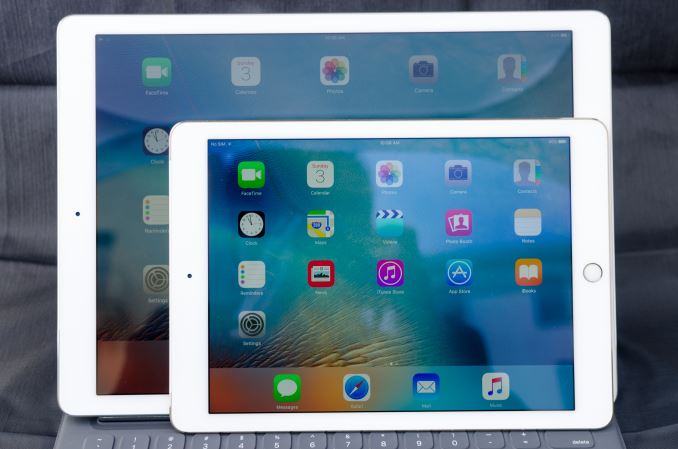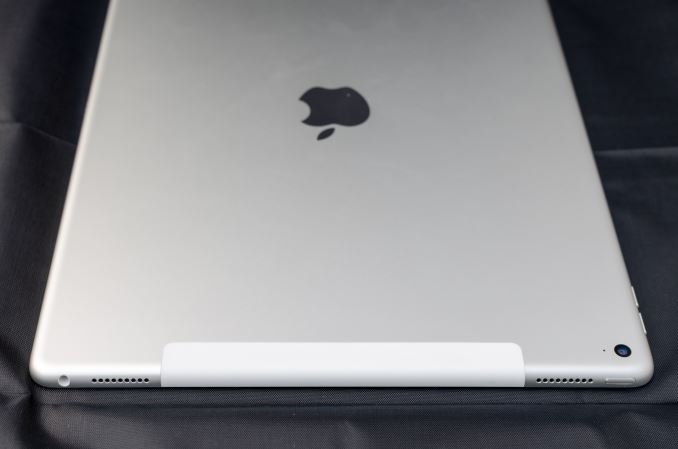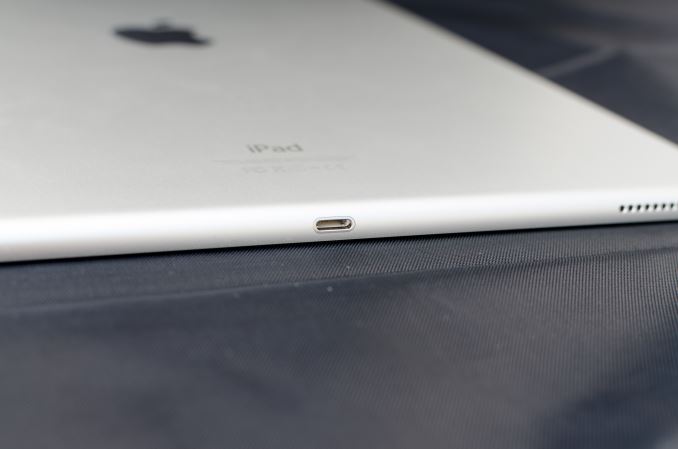The Apple iPad Pro Review
by Ryan Smith, Joshua Ho & Brandon Chester on January 22, 2016 8:10 AM EST
At this point it probably isn’t a secret that tablet sales have leveled off, and in some cases they have declined. Pretty much anywhere you care to look you’ll see evidence that the tablet market just isn’t as strong as it once was. It’s undeniable that touch-only tablets have utility, but it seems that the broader market has been rather lukewarm about tablets. I suspect at least part of the problem here is that the rise of the phablet has supplanted small tablets. Large tablets are nice to have, but almost feel like a luxury good when they’re about as portable as an ultrabook. While a compact laptop can’t easily be used while standing, or any number of other situations where a tablet is going to be better, a compact laptop can do pretty much anything a touch-only tablet can. A laptop is also going to be clearly superior for a significant number of cases, such as typing or precise pointing.
As a result, large touch-only tablets feel like they’ve been limited to home use as a computer away from the computer. Tablets are great when you’re on the couch or in bed, but once you get to this point there are some obvious questions as to whether it makes sense to drop $500+ USD on a tablet that seems to have relatively limited utility. The Surface lineup has been showing signs of growth, but in general the Surface is more of a mix between laptop and tablet rather than a tablet. I would argue that given the OS and overall design that the Surface and Surface Pro are really more laptop than tablet, even if at the hardware level the Surface Pro 4 and Surface 3 are basically tablets with kickstands and keyboard covers.
If you’re guessing that this means Apple has had some issues with growing sales of their iPad lineup, you’d be right. From my first experiences with the iPad 3, I was impressed with the improved user experience for things like web browsing and other smartphone tasks, but I never really felt like it made enough sense to get one for myself. The iPad Air 2 was once again impressive and I felt like I could recommend it to other people that wanted a tablet, but I personally struggled to come up with a reason why I would buy it.
This brings us to the iPad Pro. This is probably the first time Apple has seriously deviated from traditional iPad launches, putting together a tablet built for (limited) productivity and content creation rather than just simple content consumption, creating what's arguably the iPad answer to the Surface Pro. To accomplish this, Apple has increased the display size to something closer to that of a laptop, and we see the addition of a stylus and a keyboard cover for additional precision inputs. Of course, under the hood there have been a lot of changes as well, so the usual spec sheet can be found below to summarize those changes.
| Apple iPad Air 2 | Apple iPad Pro | |
| SoC | Apple A8X 3 x Apple Typhoon @ 1.5GHz |
Apple A9X 2 x Apple Twister @ 2.2GHz |
| GPU | PowerVR 8 Cluster Series6XT (Apple GXA6850) |
PowerVR 12 Cluster Series7XT |
| RAM | 2GB LPDDR3 | 4GB LPDDR4 |
| NAND | 16/64/128GB | 32/128GB |
| Display | 9.7" 2048x1536 IPS LCD | 12.9" 2732x2048 IPS LCD |
| Size and Mass | 240 x 169.5 x 6.1mm 437g WiFi, 444g LTE |
305.7 x 220.6 x 6.9 mm 713g WiFi, 723g LTE |
| Camera | 8MP Rear-Facing, f/2.4, 1.1 micron, 1.2MP Front-Facing, f/2.2 | |
| Battery | 27.3Wh | 38.5Wh |
| Launch OS | iOS 8 | iOS 9 |
| Cellular Connectivity | MDM9x25 Category 4 LTE + GPS/GNSS in Cellular SKU | |
| Other Connectivity | 2x2 802.11a/b/g/n/ac + BT 4.2, Apple Lightning | |
| SIM | Optional NanoSIM | |
| Price | $499/599/699 16/64/128GB | $799/949/1079 32/128GB/128GB LTE |
At a high level, the iPad Pro gains a larger display with a higher resolution, more memory, a new SoC, and a larger battery to compensate for the change in display size. In addition to these changes, the iPad Pro also brings noticeable changes to the speakers, with an increase to four speakers which allow the iPad Pro to compensate for device orientation when projecting stereo audio.
Design
The most immediate change that you can see in the iPad Pro is the sheer size. The 12.9” display of the iPad Pro basically makes it feel like you’re carrying a laptop around. I would argue that this doesn’t actually affect the portability of the iPad Pro, but this is mostly because the iPad Air 2 was something that I only carried in a backpack to begin with. People carrying their tablets in a small bag, purse, or even just in their hands will notice the difference, so the change in size might be more or less noticeable depending upon how you carry things around.
The increase in size does affect weight. After significant use, I honestly don’t think the mass is a significant issue. It does feel heavier than the iPad Air 2, but the mass distribution is such that there isn’t a ton of battery hanging out at the edges of the device where it’ll affect the moment of inertia. This does raise the question of whether Apple included enough battery for sufficient battery life, but that’s a question best left for the rest of the review.
In terms of design, the iPad Pro is rather unremarkable if you’ve ever seen an iPad Air before; it is for all intents and purposes a bigger iPad Air. On the front, the display dominates, with some bezels on the sides and top. The top has the front-facing camera, and the bottom has the home button with TouchID.
Looking at the sides of the tablet, the top edge has the power button and 3.5mm port, along with two of the four speakers. The right edge has the volume buttons, and the bottom edge has the Lightning port and the other two speakers. The left edge is mostly empty, but contains the Smart Connector for the Smart Keyboard and similar accessories.
The back of the tablet is mostly unremarkable as well. For the LTE model, an RF window is visible on the top of the device to allow LTE and other connectivity to function. For the WiFi variants, it looks like the bottom display bezel and the bottom two speakers are the RF windows, so there aren’t any visible areas that indicate where the WiFi antennas are.
Overall, the iPad Pro feels like an iPad, with nothing all that remarkable beyond its size which is carried well. I never really noticed the mass or size of the iPad Pro even if it is clearly larger and heavier than the iPad Air 2. I also didn’t notice any issues with the back cover flexing, but given enough pressure on the back cover pretty much any device this large will see some screen distortion or bending. The iPad Pro does technically regress in thickness compared to the iPad Air 2, but I never noticed the difference in practice, especially when the larger display is really what matters more.
















408 Comments
View All Comments
FunBunny2 - Saturday, January 23, 2016 - link
-- It's by now become a quasi-religious belief system for some that "mobile devices cannot ever be used for any professional purposes whatsoever!".despite what some think, Apple didn't invent the tablet. warehouses and manufacturers (when the US had them, of course) have used tablets with 802.11, and earlier protocols, for decades. all Apple did was create a consumer version.
Constructor - Saturday, January 23, 2016 - link
A "version" which "consumers" (apparently intended as a belittling epithet by you) can use, but the whole point is that it's not limited to that.akdj - Monday, January 25, 2016 - link
"You will still never be able to fit Photoshop's whole interface and abundance of options and menus into the tablet in a way that the user is easily able to reach them, without scrolling through pages of big buttons."Huh. Wonder why folks. The professional ones, for years have been buying Wacom tab companions to their 'workstation' specifically FOR PS, And EXACTLY for the reasons you outline, the ability to have precision touch and capacitance/tactile feel and response of real pencil or pen to paper. Some of these Wacom Photoshop controllers cost several times the price of the iPP for YEARS, & the iPP has its computer built in! No need to add a 'workstation'
You must've been hiding under a rock the last ½ decade. You've CERTAINLY not visited the App Store in some time. Adobe, Autoideskk Microsoft and the BIGGEST makers of "Content Creation" software are currently devoting MORE resources to mobile programming and development than their 'workstation' counterparts.
The 'big brow box' filled with diseases,; viruses - malware, adware, & the ilk's days are numbered. They're already on their way out of MANY folks' homes and offices being replaced by ultra books, passively cooled and ultra low voltage with ultra high efficiency is all the rage today. Battery life > 5 extra FPS, usability and funtionality > pure power, lotsa RAM, and expensive CPU and GPUs. Portability and the ability for 'instant on' access to their tab or phone > waiting til home, turning the power on, waiting for the boot. Opening PS (a slowly dying program with a phenomenal amount of alternatives on an iPad and iPhone and iDevice -- been that way for years, now with Adobe on board, their CreativeCloud suite offers a plethora of companion apps capable of ALL CS6's abilities as it's designed to aggregate and integrate with 'your' CC assets allowing for MOST editing ANYone will ever need on the iPad ...especially now with the display's ability to work with such an excellent active stylus and it's near direct comparison to Wacom's line of ...apparently unnessasary PS instruments and tools over the last decade or two those 'productive individuals' have made many millions of dollars in publishing? Now an AIO system with its OWN computer built in - a massive community of developers, independent to Adobe, friend next door or Autodesk themselves --- any software company interested in future survival in the industry is devoting more resources than ANY point in history to mobile dev. It's why MS, Adobe and AD were all there at the iPP unveiling. ALL demonstrating some phenomenal --- and yes, PROfessional use-case applications and software. I'm not a doctor but downloaded the examples shown at its unveiling of the Human Body atlas and AutoCAD --- its mind blowing how easily and flue to the iPad is able to manipulate such extensive detail and graphic overlays (nervous, muscular, skeletal, circulatory system overlays --- in any combination and with the ability to manipulate the direction you're looking at at a consistent 60fps) are MUCH better teaching aids - and learning that ANY static text book
Whether you ARE creating, flying a jet filled with passengers, entertaining a couple thousand folks at a concert, controlling inventory or filing your flight plan a personal pilot --- and probably 100,000 other occupations have been made significantly easier to accomplish, with less weight, more time away from the charger and 110v. That's what people need, want and are looking for. Unfortunately for Apple, they're making their iPad 'too well' --- as I've got the original, and an iPad 2 that both work, hold a charge and last as long as the Day I bought them six and five years ago respectively this year.
I also own the Air 2 and iPP and both have significantl impacts on my business I've run for nearly thirty years, successfully and exponentially dropping 'weight' every decade or so with something as capable as the always on, always connected and never a concern with battery life --- as the iPad is, easily replaces hundreds of dozens of crates of vinyl records! All while weighing about as much as a single - double record LP.
So, to summarize at the end of the day if you're a Photoshop user, you just got an incredible tool to augment your worlflow, make your photographic post production easier, organization and metadata handling, batch alteration or editing and aggregation of your library, metadata in tact and ready for post when you get home. No more off loading memory cards, organizing memory cards, redundantly dumping them for redundant/backup purposes and all the other BS that goes into using a dinosaur of a program FEW truly NEED for their projects.
Today, Adobe offers a ½ dozen "Photoshop" apps on iOS. Along with drawing, marking PDFs, even Premier and AE capture and integration (w/motion) - the options are becoming more extensive everyday, Adobe's just rewrote their entire app library and replaced each app for even better continuity for those still needing PS's tools or Acrobat's abilities beyond the $3, $5, $10 alternatives ...some, like Pixelmator, cross platform with ANY & EVERY PS tool the average layman could dream of --- available - @ the cost of a single month rental of PS/Lightroom 'rental'. And not just for hobbyists. Spend some time at DPreview.com to see the PS competition OR see Adobe's subscription tactics to maintain revenues.
It's not just a super powerful tablet. It's that and so much more thanks to an extensive and larger library of accessible software already matured to the point the App Store is - all in one place and all reasonably priced. Best prices and selection of software in history is currently more convenient and organized than ever and it's in the App Store
As devs have only had single GB of RAM, slower SoCs and smaller displays to program to over the last six years, even the Air 2 & 6s line of iPhones seems HUGE right now with double the RAM, graphics and compute. Double it again and you've got tether iPP. I'm already seeing apps available for Air 1/Mini 2 - 5s or A7/64bit iPads and newer to run the app.
As a daily user of the iPP for two months --- so many of your goofy statements make no sense, shout ignorance and beg to be straightened out --- but there's always a few schills around these parts beating an incredible product down while the masses of us are enjoying it!
Silly Murloc. What is it that makes YOU a Pro, and why is it YOUR job wouldn't be made easier or convenient with a tablet?
jlabelle - Thursday, January 28, 2016 - link
" now with Adobe on board, their CreativeCloud suite offers a plethora of companion apps capable of ALL CS6's abilities as it's designed to aggregate and integrate with 'your' CC assets allowing for MOST editing ANYone will ever need on the iPad"a very big big rant that just fall flat because of false premises. The claim above is a good example : simple case that most photographers need : Can I develop my RAW files on an iPad ?
When I mean developing, it is the normal basic reasons why you are shooting RAW in the 1st place : 1/ work in 16 bits mode so that you can push shadows / pull highlights and work on color without posterization ; 2/ apply automatically the lens correction (distorsion, CA, vignetting, ...) and 3/ have a color managed workflow (take into account the color space of the RAW file, have a calibrated display...)
The answer is ... drums rolling : you can NOT.
And you do not need a CS subscription to do that on a Surface, you can just purchase once Capture One Pro, DXO Optics... what you want. So what you can do with a Windows tablet, you simply cannot on an iPad Pro.
This is just one example but the same is true for a list so long that it makes no sense to try argue against that.
Gastec - Monday, January 25, 2016 - link
A gamer you would know what Pro moniker means.It goes like this: "I'm a Pro, gamer or whatever" meaning "I'm a big shot, a slick, better and cooler that you". And that's what iPad means when it says it's "Pro" :)
KPOM - Friday, January 22, 2016 - link
What do we need all the ports for? Most people, even in offices, can get by with wireless networks and printing these days.xerandin - Saturday, January 23, 2016 - link
Quadro*rabastens23 - Friday, January 22, 2016 - link
"Performance is better than a high end workstation from 10 years ago, a system which was capable of running professional tasks which are still nowhere to be found on mobile platforms."That's sort of an odd claim - what are those tasks, exactly? And if it's not a performance issue, why do you need an iPad Pro to do them?
ddriver - Friday, January 22, 2016 - link
Design, engineering, content creation. Basically every scenario that involves making something professionally rather than consuming something.Nobody needs a ipad pro to do this, point is the device is powerful enough for such tasks, and it would be nice if there was the software for it, in order to make that device truly PRO as in useful to professionals and not "pro" as in an empty marketing BS.
lilmoe - Friday, January 22, 2016 - link
DUDE. Software is NOT the only thing the iPad "Pro" is missing for it to be a Pro tablet. Get this through your head.The hardware is lacking even if it were much more powerful. The OS is also lacking.